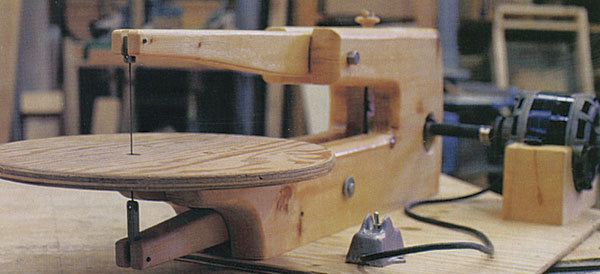The Era of Manmade Shop Machines
A generation of woodworkers overcame the high cost of machinery by building their own.

Synopsis: A look back at some of the fascinating shopmade machinery throughout the history of Fine Woodworking, from wooden tablesaws to bandsaws, planers, and more.
When it comes to outfitting our shops, today’s woodworkers have a lot of affordable machinery options. But that wasn’t always the case. Before amateur DIY and woodworking went relatively mainstream, woodworking machinery manufacturers served primarily a pro audience, which meant that prices often were out of reach for many hobbyists, and availability was limited. The solution for some woodworkers was to build their own machines. Fine Woodworking published a number of project articles from these enterprising woodworkers, who created astounding, functional machines from hardwoods, sheet goods, spare parts, and used motors.
This issue’s Looking Back highlights a few of those shopmade successes, with short excerpts from each article, explaining why or how each machine was made. One of the projects, the bandsaw above, offered plans for sale, and we still occasionally get requests for them. Another, the lathe on p. 86, actually graced our front cover.
 |
 |
Shopmade Bandsaw
“I chose a bandsaw because it can do many things a tablesaw can do, plus it can cut curves. As machinery goes, the price was right. I built the 20-in. saw for under $100, Canadian. My saw incorporates features that many store-bought saws don’t, such as a worklight above the blade guard, one drawer for blade storage and another to catch sawdust, a built-in power outlet, and a conveniently located power cord. I built it with the usual cast of characters: a saber saw, an electric hand drill, a borrowed belt sander, and my homemade 12-in. disk sander.”
William Corneil, Issue #65, 1987
 |
 |
Wooden Jointer
“Seven years ago I walked into a local hardware store to buy an odd assortment of stuff. ‘What are you going to make?’ asked the quizzical gentleman waiting on me. ‘A wooden jointer,’ I replied, trying to sound confident. He was both astonished and skeptical, and did his best to persuade me to buy the jointer on display in the store. Despite his warning, I bought the items on my list and thus embarked on my first tool-building venture. I tested five designs before I arrived at the design shown here. Its performance rivals that of an industrially produced machine, though its price (about $350) is considerably less and its feel and appearance are friendlier.”
Galen Winchip, Issue #28, 1981
 |
 |
A Wooden Tablesaw
“The only way I’d own a sliding tablesaw was if I designed and built one myself out of wood. I had already constructed a halfdozen wooden machines. Like a vintage wooden handplane, they have the friendly feel that’s absent from their cast-iron counterparts. You can modify the saw to suit your needs. After I’d built my saw, alternatives and modifications kept coming to mind, and because I’ve included these changes in the drawings, the photos and drawings don’t correspond exactly.”
Galen Winchip, Issue #41, 1983
 |
 |
Shopmade Lathes
“I designed and built this lathe to turn everything from chessmen and chair rungs to tall bedposts. The materials cost $179.25 including $30 for a used 1⁄2-hp motor, but not including some scraps of plywood and oak left over from other jobs. The spindles are made from machine steel tubing, which I threaded and reamed to a #2 Morse taper so standard Delta lathe accessories will fit. I finished the lathe with shellac and bolted it to the floor with angle irons, to keep vibration down.”
Carlyle Lynch, Issue #57, 1986
 |
 |
Mortising Machine
“The speed and accuracy of a horizontal milling machine make it an important mortising tool for anyone who builds a lot of furniture. Commercially available machines cost more than $2,000, but for about $270 I combined my Bosch 2-1⁄4 hp router and a stock Inca mortising table to come up with the sturdy home-built model shown here. The table can move back and forth enough to make a 4-in.-long mortise and up and down enough to cut a 2-1⁄2-in.-wide mortise.”
Samuel Butler, Issue #60, 1986
 |
 |
Shop-Built Thickness Sander
“As I spent more time with my digging-in, corner-dipping belt sander, I yearned for a better way to surface wood. This yearning became a necessity when I ended up with 1,500 bd. ft. of rough-sawn birch. I concluded that a power-feed drum sander was what I needed. The price was a bit of a snag, so I decided to build my own. It can sand panels up to 24 in. wide, all at a cost of $150 for parts and 50 hours assembly time.”
S.R. Cook, Issue #58, 1986
 |
 |
Shopmade Scroll Saw
“My saw performs as well as any of the factory-made machines I’ve tried. I made it as simple as possible. It consists of two parallel wooden arms mounted on a rigid wooden frame and kept in tension by the blade at one end and a stout nylon cord at the other end. The blade is driven by a pair of eccentric, rotating weights attached to the lower arm with a shaft and pillow block. An old clothes-dryer motor drives a section of rubber hose that acts as a flexible shaft to spin the weights.”
Mark White, Issue #70, 1988
For the full article, download the PDF below:
Fine Woodworking Recommended Products

Craftsman Random Orbit Sander

Fein Turbo II HEPA Wet/Dry Dust Extractor

Festool Cleantec CT 26 E HEPA Dust Extractor








Log in or create an account to post a comment.
Sign up Log in